Crepuscular Rays Explained
9 August 2013
An infrequent natural phenomenon hit the news recently. This was related to the observation of dark straight shadows in the sky by members of the public around dusk on 6 August 2013 (Figure 1). People were fascinated by this phenomenon.
This was in fact an atmospheric optics phenomenon called "Crepuscular Rays", usually referring as "rays between clouds". This is caused by sunlight being blocked by high-rise objects (such as mature cumulonimbus clouds or high mountains), thus creating strips of alternating bright and dark rays. Crepuscular rays can be observed when the sun is up in the sky or near the horizon around dawn or dusk. Anti-crepuscular rays, also known as the extension of crepuscular rays, are rays seen by an observer who faces away from the sun. Rays are seen to be converged at the antisolar point.
The crepuscular rays observed on 6 August was the result of sunlight blocked by rainclouds with elevated cloud-top developed over a hundred kilometers west-northwest of Hong Kong. The observation time was right around dusk. Rainclouds blocked the sunlight from the west, thus casting a shadow, contrasting with those without being blocked. With mid-to-high clouds associated with tropical cyclone Mangkhut over the South China Sea drifting over Hong Kong, the sky background was in rather high contrast with the sunlight. Hence, the crepuscular rays could be observed clearly.
We can even observe crepuscular rays from the meteorological satellite and weather radar images!
Generally fine weather was observed over South China from the visible satellite imagery taken at around 6 p.m. (Hong Kong Time) on 6 August 2013 (Figure 2). However, development of isolated rainclouds with elevated cloud-top could be depicted (blue and yellow circles). Shadows of long dark tails were clearly seen to the east-southeast of these clouds blocking the sunlight. Around 6:30 p.m. when the sun further approached the horizon, the dark shadows became even longer (Figure 3). You can compare the shadows circled in blue and yellow in Figures 2 and 3.
At the same time, we can even observe sunlight from the setting sun on the weather radar image at around 7 p.m. (Figure 4). Sunlight contains microwave that matches the operating frequency of the weather radar. Mostly at sunrise and sunset, the radar may capture the microwave from the sun and mistake it for its own. The radar echo thus received is in the form of a radial beam. The time of sunset in Hong Kong on 6 August was around 7 p.m. The radar image captured at around 7 p.m. (Figure 4) depicts a very well radial beam (white arrow) caused by sunlight in the direction of the setting sun.
Next time when you see some special weather phenomena, you are welcome to share them through the Community Weather Observing Scheme (CWOS) webpage on Facebook (www.facebook.com/icwos).
David Lam
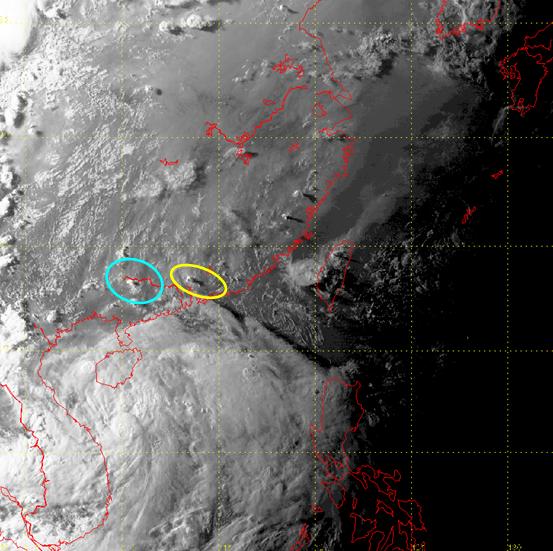
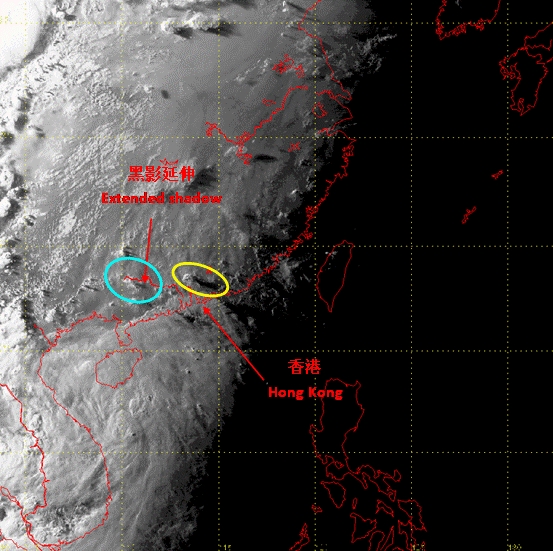
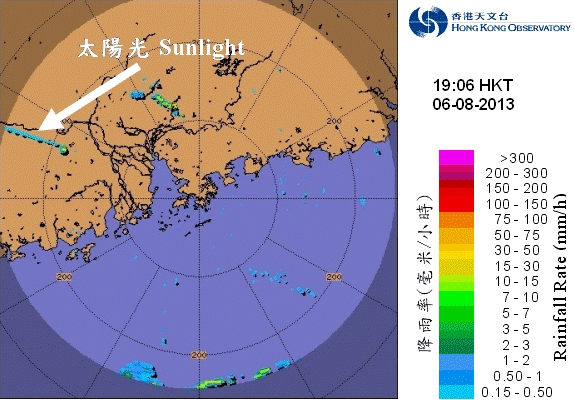
This was in fact an atmospheric optics phenomenon called "Crepuscular Rays", usually referring as "rays between clouds". This is caused by sunlight being blocked by high-rise objects (such as mature cumulonimbus clouds or high mountains), thus creating strips of alternating bright and dark rays. Crepuscular rays can be observed when the sun is up in the sky or near the horizon around dawn or dusk. Anti-crepuscular rays, also known as the extension of crepuscular rays, are rays seen by an observer who faces away from the sun. Rays are seen to be converged at the antisolar point.
The crepuscular rays observed on 6 August was the result of sunlight blocked by rainclouds with elevated cloud-top developed over a hundred kilometers west-northwest of Hong Kong. The observation time was right around dusk. Rainclouds blocked the sunlight from the west, thus casting a shadow, contrasting with those without being blocked. With mid-to-high clouds associated with tropical cyclone Mangkhut over the South China Sea drifting over Hong Kong, the sky background was in rather high contrast with the sunlight. Hence, the crepuscular rays could be observed clearly.
We can even observe crepuscular rays from the meteorological satellite and weather radar images!
Generally fine weather was observed over South China from the visible satellite imagery taken at around 6 p.m. (Hong Kong Time) on 6 August 2013 (Figure 2). However, development of isolated rainclouds with elevated cloud-top could be depicted (blue and yellow circles). Shadows of long dark tails were clearly seen to the east-southeast of these clouds blocking the sunlight. Around 6:30 p.m. when the sun further approached the horizon, the dark shadows became even longer (Figure 3). You can compare the shadows circled in blue and yellow in Figures 2 and 3.
At the same time, we can even observe sunlight from the setting sun on the weather radar image at around 7 p.m. (Figure 4). Sunlight contains microwave that matches the operating frequency of the weather radar. Mostly at sunrise and sunset, the radar may capture the microwave from the sun and mistake it for its own. The radar echo thus received is in the form of a radial beam. The time of sunset in Hong Kong on 6 August was around 7 p.m. The radar image captured at around 7 p.m. (Figure 4) depicts a very well radial beam (white arrow) caused by sunlight in the direction of the setting sun.
Next time when you see some special weather phenomena, you are welcome to share them through the Community Weather Observing Scheme (CWOS) webpage on Facebook (www.facebook.com/icwos).
David Lam
Figure 1Photos taken at around 7 p.m. on 6 August 2013 in different parts of the territory. We can see dark straight shadows appearing in the sky. Photo (a) taken by Mr. C.M. Chiu, Hong Kong Observatory Photographer. Photos (b), (c) and (d) taken by real-time webcams installed by the Observatory at various regions in Hong Kong.
(a)Chek Lap Kok Airport
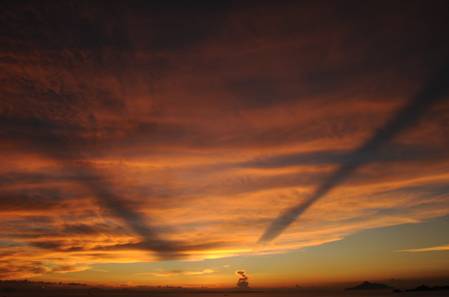
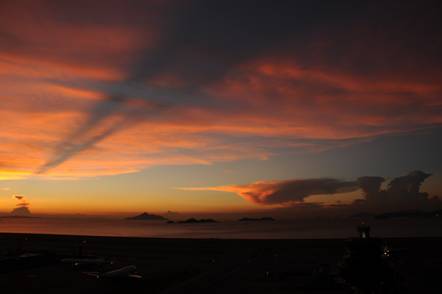
(b)Kadoorie Farm and Botanic Garden
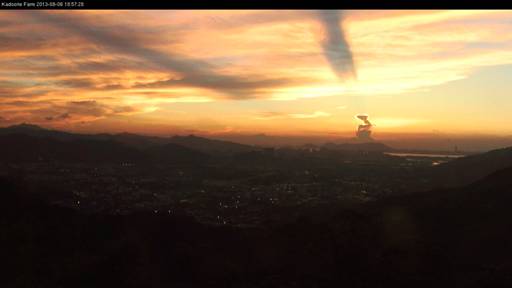
(c)Lau Fau Shan
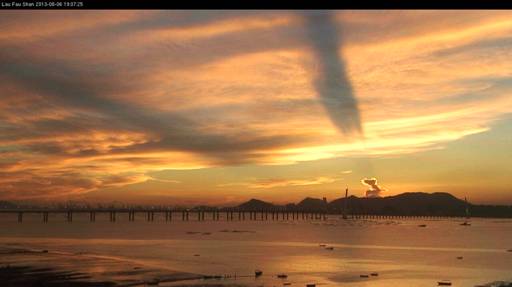
(d)Waglan Island
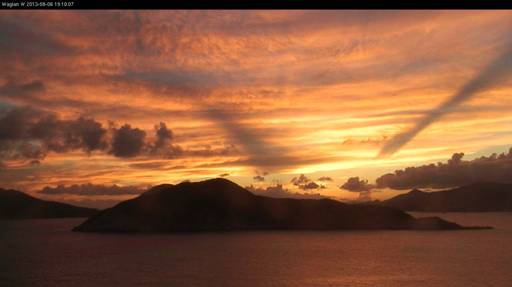
(a)Chek Lap Kok Airport


(b)Kadoorie Farm and Botanic Garden

(c)Lau Fau Shan

(d)Waglan Island

Figure 2Visible satellite imagery at around 6:00 p.m. on 6 August 2013 (Source: Japan Meteorological Agency).

Figure 3Visible satellite imagery at around 6:30 p.m. on 6 August 2013 (Source: Japan Meteorological Agency).

Figure 4Weather radar image at around 7 p.m. on 6 August 2013.
